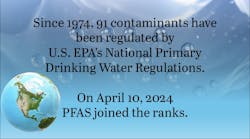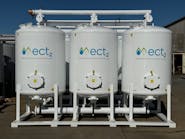Water industry associations respond to PFAS MCL announcement
The announcement from EPA generated responses from industry associations. These association memberships include the utility personnel who will be tasked with carrying out the treatment at water plants to ensure PFAS limits are met, the engineers and consultants who design those plants, contractors who construct the projects, educational institutions that conduct research, and primacy professionals tasked with ensuring regulations are implemented and enforced.
Water Environment Federation (WEF)
"Ultimately, the new rule will have significant impact on wastewater treatment systems in several direct and indirect ways. Some of the most concerning are as follows:
- Water resource recovery facilities (WRRFs) that discharge to surface waters that also serve as sources for drinking water will face increased pressure to reduce PFAS in their effluent., Over the next several years EPA also plans to implement PFAS limits in National Pollutant Discharge Elimination System (NPDES) permits.
- The cost of compliance with the new MCL will be extremely expensive, and these costs will be borne by ratepayers. This will significantly reduce the availability of rate increases for wastewater infrastructure investments because both drinking water and wastewater systems have the same ratepayers.
- All utilities will face many questions from customers about how they are addressing this issue, which will require significant public communications and outreach."
"The MCL standard is part of a larger matrix of interconnected regulatory and treatment strategies for dealing with PFAS," said Steve Dye, Senior Director of Government Affairs for the Water Environment Federation, in a statement. "It will fall on utilities and the water sector as a whole to address all the approaches to the problem, and WEF members will be dealing with these regulations on the front lines. We urge EPA, legislators, state regulators and the public to recognize the far-reaching impacts of the new MCLs and the significant costs of compliance to be borne by every American.”
American Water Works Association (AWWA)
In a comment submitted to WaterWorld the AWWA said that it “supports strong drinking water standards that protect public health. AWWA submitted extensive comments to the U.S. Environmental Protection Agency on its proposed PFAS rule and is evaluating the content of the final regulation."
"The Safe Drinking Water Act provides a framework to evaluate risks and create regulations that are both protective and affordable. This process assists water utilities in prioritizing investments in a way that best protects their communities. As noted in AWWA’s comments on the proposed rule, the association is concerned that the rule’s health and financial impacts are not accurately characterized. AWWA estimates the cost of the rule is more than three times higher than the agency’s calculations. The magnitude of these additional costs will lead to affordability challenges in many communities.
The best way to keep our drinking water free from PFAS is to protect our precious source waters. AWWA continues to encourage EPA to follow through on its commitments to address harmful PFAS manufacturing, uses, and releases to the environment. Doing so appropriately requires polluters – not communities – to be held responsible for PFAS contamination.”
The AWWA said they’re committed to finding solutions that protect communities from PFAS contamination.
Association of State Drinking Water Administrators (ASDWA)
"ASDWA supports EPA's drinking water standards for PFOA, PFOS, and four other PFAS. EPA's drinking water standards for PFOA, PFOS, and four other PFAS in drinking water are a step in the right direction to provide national consistency for addressing PFAS in drinking water. Now the challenging work for the primacy agencies begins so that this rule is implemented effectively to protect public health," the ASDWA said in a statement.
"ASDWA's members will ensure that systems across the country have the tools and assistance to comply with this rule. Additional guidance in several key areas of the rules is needed from EPA soon to assist both state drinking water programs and systems to prepare for implementation. Additionally, this rule creates significant challenges in several areas for drinking water programs and for water systems such as laboratory certification, balancing multiple EPA priorities with limited workforce, operator certification, and managing federal grants.
The standards are very close to the detection/reporting limits for PFOA and PFOS. States will be responsible for the certification of laboratories to ensure accurate compliance monitoring results.
The standards will require thousands of public water systems across the country to add advanced treatment to their current water treatment. States will have to review and approve the plans and specifications for this advanced treatment, competing with increased workloads from other regulations such as the Lead and Copper Rule Revisions/Improvements (LCRR/LCRI) and infrastructure projects being funded by the Infrastructure Investment and Jobs Act (IIJA). In addition to the need for systems to conduct pilot testing of multiple treatment options, the construction, operations, management, and sampling costs will be significant and will likely extend into billions of dollars."
The National Association of Water Companies (NAWC)
“In the absence of federal regulations, private, regulated water and wastewater companies who are members of NAWC have been working to control PFAS in their systems as part of their ongoing commitment to their communities to provide safe, reliable service. By establishing a national standard for addressing PFAS in the nation’s water supply, the EPA provides clarity to all states, utilities and their consumers, leveling the playing field,” said Robert F. Powelson, President and CEO of NAWC.
“NAWC’s thanks the EPA for recognizing the need for additional flexibility in timing to comply with the final rule but is concerned that estimates on customer costs and the number of water systems impacted are understated.”
“What is clear is that meeting these new federal regulations will cost billions of dollars. It’s a cost that will disproportionately fall on water and wastewater customers in small communities and low-income families. The next step must now be to develop a system where the polluters are held responsible for the cleanup not our consumers.”
“Water utilities do not create or produce PFAS chemicals – nor are they used in the water or wastewater treatment process. Yet water systems and their customers are on the front lines of paying for the cleanup of this contamination – and are doing so within the boundaries of all existing regulations.”
The American Chemistry Council (ACC)
In an April 10 press release the ACC comments on the new EPA National Primary Water Drinking Regulation (NPDWR) for certain PFAS contaminants.
“Unfortunately, there are serious concerns with the underlying science used to develop these Maximum Contaminant Levels (MCLs). These concerns have been validated by peer-reviewed research that also calls into question the basis for EPA’s overly conservative approach to assessing one of the health endpoints. Even EPA’s own Science Advisory Board severely criticized much of the underlying science behind the proposed standards.”
The ACC underscores the need to thoughtfully follow sound science, amongst growing water scarcity and other water priorities.
“Furthermore, around the country, local governments, water agencies, and concerned organizations have commented on the proposal and raised many of the same concerns presented by ACC. The American Water Works Association has also found that this will cost almost $4 billion annually – several times more than what EPA estimated. These new regulations also fail to accurately assess the benefits to local communities and don’t take into account other higher-priority water and infrastructure issues for local water systems,” ACC states in the release.
“Since this proposal was first announced, new real-world data has become available through national monitoring that confirms the rationale for this proposal is based on inaccurate and out-of-date information. Failure to incorporate this data into the final rule means that the number of small water systems that will be impacted by the new standard is three times higher than EPA estimated, forcing them to divert critical resources away from other higher-priority drinking water needs.
“We strongly support the establishment of a science-based drinking water standard, but this rushed, unscientific approach is unacceptable when it comes to an issue as important as access to safe drinking water. We strongly oppose this rule and will be working with the broad range of concerned stakeholders to determine next steps.”
Water industry companies and advocates provide comment
The following comments come from companies or indsutry advocates, such as legal firms. These manufacuters develop, build, engineer and sell the equipment necessary to treat PFAS chemicals in drinking water. The legal firms have taken action against companies that created the PFAS chemicals and released them into the environment, leading to the need for the PFAS MCL.
Xylem
“PFAS contamination is one of the most widespread water challenges facing communities across the country, as indicated by today’s EPA PFAS Regulation,” Xylem said in a statement.
“The issue represents a significant challenge for utilities committed to delivering safe water to their communities. With an estimated 45% of U.S. drinking water containing PFAS, more than 5,000 utilities will have to take action to reduce contamination. The scale of that challenge shouldn’t be underestimated.
Fortunately, there are practical ways for communities to remove PFAS from drinking water. Proven solutions exist.
The best available technologies highlighted by the EPA, such as granular activated carbon and ion exchange resins, have already demonstrated their efficacy in purifying water in many communities across the country.
Support for water utilities from all stakeholders is essential. It will take a concerted effort for communities to tailor response plans, deploy treatment solutions to community-specific challenges, and access the necessary funding. But we’re not starting from scratch. The utilities and technology providers that have already deployed PFAS mitigation solutions know how to get the job done, and they can help others safeguard their communities’ water.”
AqueoUS Vets
“The EPA’s newly announced national drinking water standards for PFAS will create challenges for the water utilities as they are challenged to meet the new standards. Leveraging our mission of removing PFAS and other harmful contaminants from the US water supply to protect our health and environment, AqueoUS Vets is committed to providing the water industry with the highest level of experience, reliability, and project management,” said AqueoUS Vets in a statement.
“By bridging the knowledge gap between engineering, manufacturing, installation, and commissioning with a consultative approach, AqueoUS Vets will work with each client to develop a customized solution based on water quality, treatment needs, and site location delivering state-of-the-art filtration systems at the most cost-effective rate to ensure compliance with the new maximum contaminant levels (MCLs) for PFAS.”
CDM Smith
"The final PFAS MCL rule is a significant milestone, being the first-ever, national drinking water standard to protect communities from these regulated per-and polyfluoroalkyl substances (PFAS). In many ways the final rule is very similar to the draft proposed in 2023," CDM Smith said in a statement.
"Of significant note is that maximum contaminant levels (MCLs) for perfluorooctanoic acid (PFOA) and perfluorooctane sulfonic acid (PFOS) were kept at the very low level of 4.0 parts-per-trillion (ppt). This is expected to remain the most challenging part of the rule for many water systems to comply with. A notable modification between the draft and final rules is the change in the compliance value of the Hazard Index (HI) from 1.0 to 1. While this may appear minor, the index actually allows for almost a 50% increase in the compliance value since HI values below 1.5 would round down to 1, thus still in compliance with the final rule."
" Another significant change in the final rule is the 2-year extension in the compliance deadline that allows utilities that need to construct treatment modifications the time required to complete those capital projects. This is key given the anticipated extended lead times for the procurement of treatment vessels, media, and/or membranes due to the simultaneous demand from water systems across the nation."
De Nora
“The most recent estimates suggest 70 million Americans are drinking water with PFAS levels above the EPA’s maximum contaminant level of 4 parts per trillion, which was approved today,” said Marwan Nesicolaci, CEO of De Nora Water technologies, in a statement.
“Fortunately, the water industry has had ample time to prepare for this moment, and even longer when you’re able to apply the same technology to address emerging challenges. De Nora SORB systems have been trusted by thousands of utilities for more than two decades to remove contaminants of concern from water, such as arsenic, iron and manganese. Our dedicated team has optimized its PFAS line over the last two years to support its partners working through the compliance process, both in the US and in other areas addressing this global concern.”
Jacobi Carbons
“Today marks a pivotal moment in US water history, as the EPA’s national primary drinking water standards for PFAS have received final approval. As a leading supplier of two of the three recommended technologies for PFAS removal in drinking water, including activated carbon and ion exchange resin, our team is available to offer comprehensive support to water providers across the country as they adapt to this new era of water regulations. Whether it’s a question on testing, the maximum contaminant levels (MCLs) or treatment options, we are here to help tackle PFAS together,” said Jim Knepper, president of Jacobi Carbons.
SL Environmental
"While long expected, the announcement of the EPA's final national drinking water standards for PFAS will pose significant challenges for public water systems throughout the country. Complying with these rigorous standards will entail significant costs, likely stretching well into the future as these entirely manmade 'forever chemicals' continue to persist in the environment. We remain committed to assisting our water utility clients in their efforts to ensure that the manufacturers of these chemicals, and the products containing them, bear as much of these costs as possible" said Ken Sansone, partner, SL Environmental.
Environment America
“The EPA is taking a vital step toward protecting our drinking water from the toxic scourge of PFAS – including assistance for rural Americans” said John Rumpler, Environment America Research & Policy Center Clean Water Director, in a press release. “Hopefully, this rule also reinforces the message that it is time to stop using these chemicals in the first place.”
The Great Lakes PFAS Action Network
“This is a monumental victory for the American people and a new beginning for impacted communities across the country,” said Tony Spaniola, co-chair of the Great Lakes PFAS Action Network, in a press release. “These PFAS drinking water standards will save the lives of countless Americans for generations to come. Thank you to President Biden for putting public health and science above the demands of powerful special interests.”
“I have experienced on a personal level what happens when these contaminants are not regulated and in our water,” said Sandy Wynn-Stelt, a Great Lakes PFAS Action Network co-chair, in a press release. “These are important steps that will protect human health and the environment for generations to come. It could not have occurred without the dedication of activities, groups, and agencies working together. And there is still work to do.”
Sandy Wynn-Stelt is a resident of Belmont, Michigan, where drinking water is contaminated with PFAS.
Communications professionals weigh in on PFAS MCL
A vital compontent of the PFAS MCL is communicating what the regulation means for the public. As noted in the comments above, there are many challenges related to this new regulation, which will require considerable effort to ensure utilities have the resources to properly communicate what PFAS are, how their system currently addresses the need, what future actions they'll need to take, the funding necessary to meet the new standard, and ultimately why it is important to remove PFAS chemicals from drinking water.
Water PIO
“Today is the day many of us who work in water have feared for years: the day when the EPA would dictate drinking water standards—based on a mix of political, legal, and scientific reasoning—that punish the victims of PFAS pollution instead of the actual polluters. Today is the day the EPA willfully decided to put thousands of blameless water providers in a position to fail. When it knows they do not produce or use a single drop of PFAS. Not one,” said Mike McGill, President of WaterPIO and PFASComms.com, in a statement.
“In recent years, several states developed stringent standards while the EPA failed to act. These states used their extensive academic and scientific resources to develop PFAS standards that both protect public health and put water providers in a position to succeed.”
“Instead of working with the states, the EPA ignored their expertise; its estimates comparing health benefits over what the states set while costing thousands of water systems—and their customers—hundreds of billions of dollars to comply, not simply $1.5 billion a year.”
“NO ONE is supporting the existence of PFAS in our drinking water. Like many other substances regulated under the Safe Drinking Water Act, however, a balance can be made that protects public health AND the affordability of the nations drinking water. Today, the EPA not only failed to strike that balance, it permanently upset it. And the American people—not the polluters—will pay for it.”
“The EPA highlights how billions in funding are available, along with its longer timetable for compliance. However, it knows the money isn’t nearly enough for this massive mandate. It knows five years isn’t enough time for most providers to choose and build the right solutions. And it know it is putting the nation’s water systems—the widespread victims of PFAS pollution—in a position to fail.”
Non-profits and organizations outside the water industry
Given the prolific nature of PFAS contamination, it comes as not surprise that organizations from outside the water industry bubble are also weighing in on the new PFAS MCL. These comments provide perspective for water professionals to better understand where the public sentiment on the new regulation likely lies.
National Wildlife Federation
“The contamination of our drinking water supplies with these toxic chemicals is an urgent public health risk – particularly for the most vulnerable among us,” said Jim Murphy, senior director of legal advocacy at the National Wildlife Federation, in a press release. “We welcome the Biden Administration’s new drinking water standards for six types of highly toxic PFAS. We look forward to working with the Administration as we work to turn off the tap on PFAS contamination before it enters our waters in the first place.”
"Access to clean and safe drinking water is crucial for every community to thrive,” said Taofik Oladipo, policy manager for environmental justice, health, and community resilience at the National Wildlife Federation, in a press release. “The EPA’s final PFAS drinking water rule is an important step toward ensuring that environmental justice communities do not continue to be disproportionately burdened by PFAS pollution in drinking water, safeguarding both public health and community resilience."
The Great Lakes Region at the National Wildlife Federation
“The new drinking water standards are a tremendous victory for the community members who have fought tirelessly for the health of their families and ours,” said Rebecca Meuninck, regional executive director of the Great Lakes Region at the National Wildlife Federation, in a press release. “Roughly 100 million Americans now have assurances that their water will be free of these toxic chemicals.”
A brief history and definition of PFAS
The Environmental Protection Agency (EPA) was first alerted to the risks of “forever chemicals” in 1998. Over a quarter century later the EPA is setting limits on per- and polyfluoroalkyl substances (PFAS) in drinking water.
PFAS are human made chemicals that are difficult to break down and dispose of. They build up in human bodies when consumed through drinking water. Emerging technology and guidance has made it possible to breakdown PFAS and begin meeting the new EPA’s guidelines.
This will be the first Maximum Contaminant Level (MCL) set by the EPA since arsenic was updated in 2001.
It will fall onto the water industry, places like water utilities and wastewater treatment plants, to work on and monitor PFAS in our drinking water, with guidance from the EPA.





